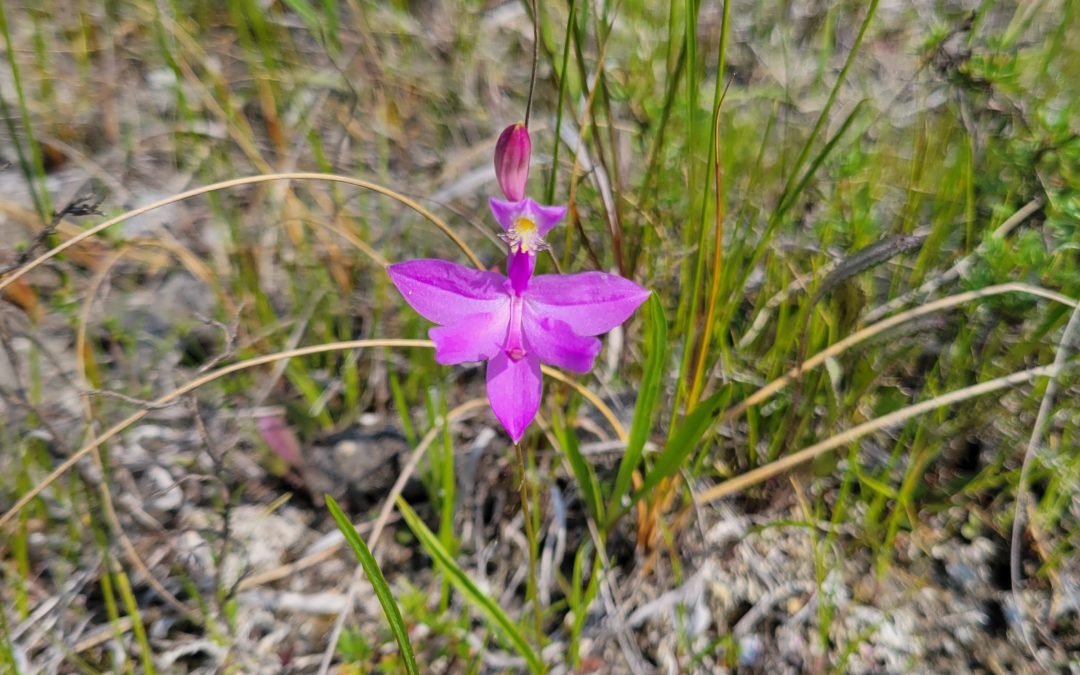By Alicia Addams, Tina Ni and Brianna Saylor, Invasive Species Management Assistants
Bergen Swamp is a 2,000-acre nature preserve owned and maintained by the Bergen Swamp Preservation Society in Genesee County, New York. The preserve contains various diverse ecosystems such as calcium-rich marl fens, cedar swamps and pine-hemlock forests. These diverse ecosystems create unique habitats, making it the perfect environment for many rare, native plants and animals, and the preserve has been recognized as a National Natural Landmark.
Bergen Swamp is a remnant of an ancient glacial lake called Lake Tonawanda. The nature preserve is located on top of shale, surrounded by dolomite and limestone. As water flows through the surrounding areas, the water entering the preserve is rich in calcium, resulting in the unique calcium-rich marl fens. The unique geology and hydrology of Bergen Swamp allows the nature preserve to host over 2,000 plant species. Some highlights include round-leaved sundews (Drosera rotundifolia), northern purple pitcher plants (Sarracenia purpurea), grass pink orchids (Calopogon tuberosus), and yellow and white lady’s slippers (Cypripedium parviflorum, C. candidum). Bergen Swamp also has a variety of birds that do not breed anywhere else in the Lake Ontario region, including five owl species. The nature preserve is also home to the coal skink (Plestiodon anthracinus), which is the only lizard found in western New York, and one of only four lizard species found in New York State. These plant and wildlife species make Bergen Swamp a priority area for preservation and conservation.
To aid in the preservation of this ecological landmark, the WNY PRISM Crew (Crew) conducted management of Japanese barberry (Berberis thunbergii) in 2.14 acres of wooded area located off the main trail for two days in June 2022. They returned for another two days in September 2022 to manage common reed (Phragmites australis). Phragmites was managed in areas to protect valuable habitat for endangered turtles and snakes. Rapid habitat loss has caused the decline of these species, highlighting the importance of managing invasive species surrounding their habitat.
The Crew returned to this exciting location in 2023 to continue to help protect biodiversity at Bergen Swamp by managing the spread of invasive species. This time, the Crew focused on treating slender false brome (Brachypodium sylvaticum), an invasive grass that started to take over the ground cover at the preserve several years ago. It outcompetes native plants and threatens Bergen Swamp’s unique environment. The Crew managed slender false brome for a total of four days, resulting in a treatment area of 2.35 acres. The treated area is located at the Pocock entrance and follows the Pocock Trail in towards the hemlock knoll, and plants were treated 20 feet off trail on each side. The slender false brome started as a monoculture with few native species peeking through before the first round of management in 2023 and was found at significantly lower densities during the follow up visit later in the season.
The Crew also dedicated two days to the control of Phragmites in 2023, in different areas than the previous year. They worked hard to treat areas surrounding the Pocock Trail to suppress the spread of this species, which has increased over the last several years. Over the two days, the Crew treated 0.51 acres of large but sparsely dispersed patches of Phragmites to prevent further spread into areas that are free of this invasive species. The Crew also revisited the areas treated in 2022, and saw little to no regrowth of Phragmites, so these management efforts will increase habitat for native plants and animals. This will hopefully increase sightings of unique species by partners and visitors of Bergen Swamp.
The Crew enjoyed learning about the native plant and animal life that inhabit Bergen Swamp and had fun working at this site. They got to see species such as fen grass of Parnassus (Parnassia glauca) and large marsh ferns. This was a great opportunity to practice species identification and see plants that are uncommon in western New York. The Crew felt a sense of satisfaction that the hard work they put in this season was evident in the number of native species seen during follow up treatment. Working in a highly sensitive area felt meaningful and reminded the Crew that a huge impact can be made through invasive species management. The sound of tree frogs chirping and hawks flying overhead made this project special and was a reminder of why the Crew put so much effort into their profession.





